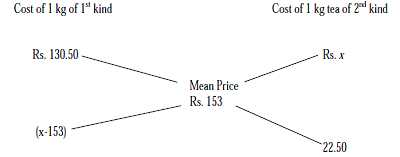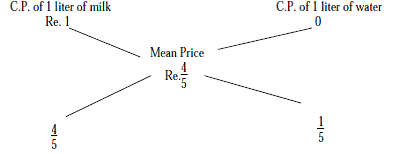Aptitude Alligation Or MixturePage 2
9. |
|
Answer is: BAverage distance traveled in one hour = 80/7 km.

By alligation rule,
(Time taken on foot)/(Time taken on bicycle) = 32 : 24 = 4 : 3.
Thus out of 7 hours in all, he took 4 hours to travel on foot.
Distance covered on foot in 4 hours = (4 x 8) km = 32 km.

By alligation rule,
(Time taken on foot)/(Time taken on bicycle) = 32 : 24 = 4 : 3.
Thus out of 7 hours in all, he took 4 hours to travel on foot.
Distance covered on foot in 4 hours = (4 x 8) km = 32 km.
10. |
|
Answer is: AAverage money received by each = 4100/50 paise = 82 paise.

By alligation rule,
Ratio of boys and girls = 17 : 8.

By alligation rule,
Ratio of boys and girls = 17 : 8.
11. |
|
Answer is: BIf one lump is mixed with the quantities of metals interchanged then the mixture of the two lumps would contain 18 gm of first metal and 18 gm of second metal and the price of the mixture would be Rs. (87 + 78.60) or 165.60.
Cost of(18 gm of 1st metal + 18 gm of 2nd metal) = Rs. 165.60
So, cost of (1 gm of 1st metal + 1 gm of 2nd metal) = (Rs.165.60)/18 =
Rs. 9.20.
(Cost of 1 gm of 1st metal) + (Cost of 1 gm of 2nd metal) = Rs. 9.20.
Cost of 1 gm of 2nd metal = Rs. (Rs. 9.20 – 6.70) = Rs. 2.50.
Now, mean price of lump = Rs. (87/18) per gm. = Rs. (29/6).

By alligation rule,
Quantity of 1st metal/Quantity of 2nd metal = 14/6 : 56/30 = 5 : 4.
In 9 gm of mix., 2nd metal = 4 gm.
In 18 gm of mix., 2nd metal = (4/9) x 18 gm = 8 gm.
Cost of(18 gm of 1st metal + 18 gm of 2nd metal) = Rs. 165.60
So, cost of (1 gm of 1st metal + 1 gm of 2nd metal) = (Rs.165.60)/18 =
Rs. 9.20.
(Cost of 1 gm of 1st metal) + (Cost of 1 gm of 2nd metal) = Rs. 9.20.
Cost of 1 gm of 2nd metal = Rs. (Rs. 9.20 – 6.70) = Rs. 2.50.
Now, mean price of lump = Rs. (87/18) per gm. = Rs. (29/6).

By alligation rule,
Quantity of 1st metal/Quantity of 2nd metal = 14/6 : 56/30 = 5 : 4.
In 9 gm of mix., 2nd metal = 4 gm.
In 18 gm of mix., 2nd metal = (4/9) x 18 gm = 8 gm.
12. |
|
Answer is: CSince first and second varieties are mixed in equal proportions.
So, their average price = Rs.(126 + 135)/2 = Rs. 130.50
So, the mixture is formed by mixing two varieties, one at Rs. 130.50/kg and the other at say,
Rs. X per kg in the ratio 2 : 2, i.e., 1 : 1. We have to find X.
By the rule of alligation, we have:

(X – 153)/22.50 = 1
X - 153 = 22.50
X = 175.50
So, their average price = Rs.(126 + 135)/2 = Rs. 130.50
So, the mixture is formed by mixing two varieties, one at Rs. 130.50/kg and the other at say,
Rs. X per kg in the ratio 2 : 2, i.e., 1 : 1. We have to find X.
By the rule of alligation, we have:

(X – 153)/22.50 = 1
X - 153 = 22.50
X = 175.50
13. |
|
Answer is: BLet the cost of 1 liter milk be Re. 1.
Milk in 1 liter mix. in 1st can = ¾ liter,
C.P. of 1 liter mix. in 1st can Rs. = 3/4
Milk in 1 liter mix. in 2nd can = ½ liter,
C.P. of 1 liter mix. in 2nd can Rs. = 1/2
Milk in 1 liter of final mix. = 5/8 liter,
Mean price = Re. 5/8
By the rule of alligation, we have:

Ratio of two mixtures = 1/8 : 1/8 = 1 : 1
So, quantity of mixture taken from each can =( ½) x 12 = 6 litres.
Milk in 1 liter mix. in 1st can = ¾ liter,
C.P. of 1 liter mix. in 1st can Rs. = 3/4
Milk in 1 liter mix. in 2nd can = ½ liter,
C.P. of 1 liter mix. in 2nd can Rs. = 1/2
Milk in 1 liter of final mix. = 5/8 liter,
Mean price = Re. 5/8
By the rule of alligation, we have:

Ratio of two mixtures = 1/8 : 1/8 = 1 : 1
So, quantity of mixture taken from each can =( ½) x 12 = 6 litres.
14. |
|
Answer is: CLet C.P. of 1 liter milk be Rs. 1.
Then, S.P. of 1 liter of mixture = Re. 1, Gain = 25%.
C.P. of 1 liter mixture = Re (100/125) x 1 = 4/5.
By the rule of alligation, we have

Ratio of milk to water = 4/5 : 1/5= 4 : 1.
Hence, percentage of water in the mixture =[(1/5) x 100]% = 20%.
Then, S.P. of 1 liter of mixture = Re. 1, Gain = 25%.
C.P. of 1 liter mixture = Re (100/125) x 1 = 4/5.
By the rule of alligation, we have

Ratio of milk to water = 4/5 : 1/5= 4 : 1.
Hence, percentage of water in the mixture =[(1/5) x 100]% = 20%.
15. |
|
Answer is: DS.P. of 1 kg of mixture = Rs. 9.24, Gain 10%.
C.P. of 1 kg of mixture = Rs.(100/110) x 9.24 = 8.40
By the rule of alligation, we have:

Ratio of quantities of 1st kind and 2nd kind = 14 : 6 = 7 : 3.
Let X kg of sugar of 1st be mixed with 27 kg of 2nd kind.
Then, 7 : 3 = X : 27
X = (7 x 27)/3 = 63 kg.
C.P. of 1 kg of mixture = Rs.(100/110) x 9.24 = 8.40
By the rule of alligation, we have:

Ratio of quantities of 1st kind and 2nd kind = 14 : 6 = 7 : 3.
Let X kg of sugar of 1st be mixed with 27 kg of 2nd kind.
Then, 7 : 3 = X : 27
X = (7 x 27)/3 = 63 kg.
16. |
|
Answer is: DAmount of milk left after 3 operations = [40(1- 4/40)³] liters.
Amount of milk left after 3 operations = 40[(9/10) x (9/10) x (9/10)].
Amount of milk left after 3 operations = 29.16 litres.
Amount of milk left after 3 operations = 40[(9/10) x (9/10) x (9/10)].
Amount of milk left after 3 operations = 29.16 litres.
Comments
No comment yet.